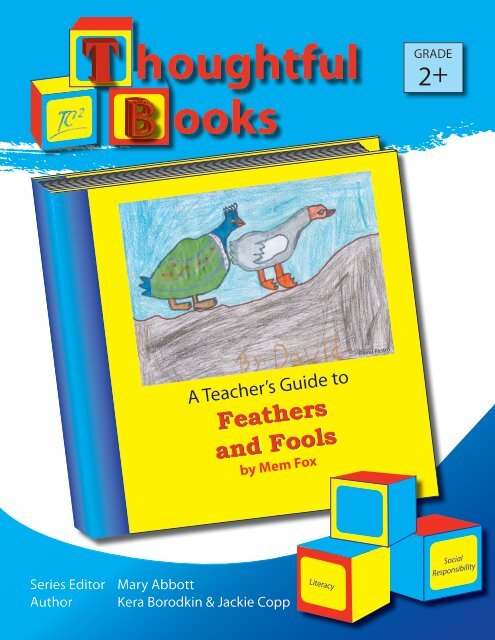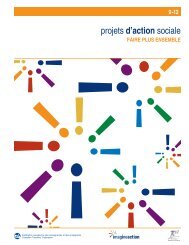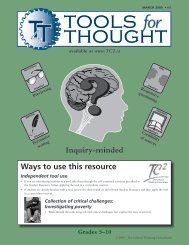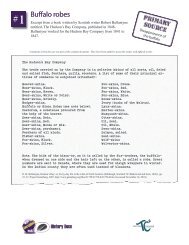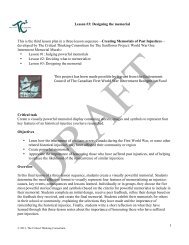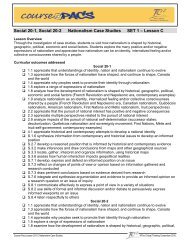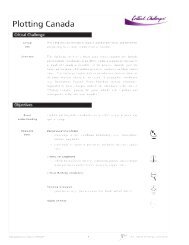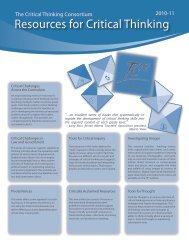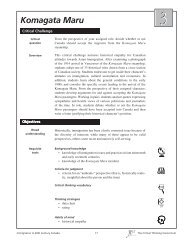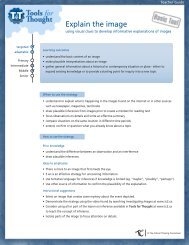Feathers and Fools - The Critical Thinking Consortium
Feathers and Fools - The Critical Thinking Consortium
Feathers and Fools - The Critical Thinking Consortium
You also want an ePaper? Increase the reach of your titles
YUMPU automatically turns print PDFs into web optimized ePapers that Google loves.
houghtful<br />
ooks<br />
GRADE<br />
2+<br />
A Teacher’s Guide to<br />
<strong>Feathers</strong><br />
<strong>and</strong> <strong>Fools</strong><br />
by Mem Fox<br />
David Pastro<br />
Series Editor Mary Abbott<br />
Author Kera Borodkin & Jackie Copp<br />
Literacy<br />
Social<br />
Responsibility
Note to parents <strong>and</strong> teachers<br />
<strong>The</strong> Thoughtful Books Series makes use of exemplary children’s literature to help young readers learn to<br />
read critically <strong>and</strong> to thoughtfully consider ethical matters. <strong>Critical</strong> thinkers rely on inquisitive attitudes,<br />
utilize thinking strategies, access background knowledge, underst<strong>and</strong> thinking vocabulary, <strong>and</strong> apply<br />
relevant criteria when making thoughtful decisions. We refer to these attributes as intellectual tools.<br />
Each resource in this series features specific intellectual tools supporting literacy development <strong>and</strong><br />
ethical deliberation. Teachers <strong>and</strong> parents can introduce the tools using the suggested activities in this<br />
resource, <strong>and</strong> then support learners in applying the tools in various situations overtime, until children<br />
use them independently, selectively, <strong>and</strong> naturally.<br />
Reading as thinking<br />
Reading is more than decoding words. It is the active process of constructing meaning. Good readers<br />
underst<strong>and</strong> this process as engagement in critical thinking. <strong>The</strong>y employ specific literacy competencies<br />
as they engage with text, create meaning from text, <strong>and</strong> extend their thinking beyond text. <strong>The</strong> activities<br />
in this booklet help develop the following literacy competencies:<br />
• Accessing background knowledge: Good readers draw on what they already know to establish a foundation<br />
for approaching new texts. In this case, students share their underst<strong>and</strong>ing of the ways people<br />
are the same <strong>and</strong> the ways they differ.<br />
• Finding Important ideas: Good readers discriminate between details <strong>and</strong> key or important ideas. In<br />
this case, students identify unique qualities in the story <strong>and</strong> create a storyboard of the events leading<br />
to the destruction that occurs in the story. Good reader also use details <strong>and</strong> messages gleaned from the<br />
text to discern key ideas <strong>and</strong> themes that may not be explicit in the text. In this case, students identify<br />
the message or lesson of the story.<br />
• Synthesizing ideas: Good readers think about <strong>and</strong> respond to issues <strong>and</strong> themes critically. In this case,<br />
students identify an act of tolerance that would change the story. <strong>The</strong>y also examine the concept of<br />
“lessons” <strong>and</strong> connect the lesson(s) in the story to everyday situations..<br />
Ethical considerations<br />
A second focus of the activities in this booklet is to help learners develop the intellectual tools they need<br />
to think critically about ethical considerations. It is important to teach the tools, often through modelling<br />
<strong>and</strong> illustrating with examples, <strong>and</strong> continue to apply the tools in a variety of situations over time, until<br />
learners internalize them. <strong>The</strong> following ethical consideration is addressed in this resource:<br />
• Tolerance of difference: <strong>Critical</strong> thinkers are able to suspend judgment <strong>and</strong> demonstrate curiosity <strong>and</strong><br />
interest in things that are unfamiliar. In this case, students explore the concept of tolerance <strong>and</strong> the<br />
responsibility to intervene in circumstances of intolerance.
teacher’s g u i d e f o r:<br />
<strong>Feathers</strong> <strong>and</strong> <strong>Fools</strong><br />
by Mem Fox<br />
Grade 2+<br />
4 sessions<br />
<strong>Critical</strong> question<br />
What is the most important lesson in this story?<br />
Story<br />
Whoever You Are by Mem Fox, Leslie Staub illustrator, Voyager<br />
(2001). Use this story as a lead-in if desired.<br />
<strong>Feathers</strong> <strong>and</strong> <strong>Fools</strong> by Mem Fox, Nicholas Wilton illustrator, Voyager<br />
(2000).<br />
Summary<br />
Whoever You Are is a simply written, vividly illustrated book showing<br />
how people all over the world are different <strong>and</strong> the same. Use these<br />
activities to introduce students to the idea of tolerance <strong>and</strong> celebrating<br />
differences. If students are familiar with these concepts, simply review<br />
them briefly <strong>and</strong> proceed to the introduction of <strong>Feathers</strong> <strong>and</strong> <strong>Fools</strong>.<br />
<strong>Feathers</strong> <strong>and</strong> <strong>Fools</strong> is a beautifully illustrated <strong>and</strong> thought provoking<br />
story that tells what happens when a group of peacocks <strong>and</strong> swans are<br />
afraid of each other because of their differences. Use the accompanying<br />
activities to help children underst<strong>and</strong> the concept of tolerance <strong>and</strong> the<br />
responsibility to take action in the face of intolerance.<br />
Main focus<br />
Literacy competencies<br />
• accessing background knowledge<br />
• finding important ideas<br />
• synthesizing ideas<br />
Ethical considerations<br />
• celebrating difference<br />
• tolerance of difference<br />
Levels of involvement<br />
Consider students’ interest <strong>and</strong> their level of maturity to determine<br />
whether or not all three levels of after-reading activities are appropriate.<br />
• Exposure: identify tolerant <strong>and</strong> intolerant behaviours.<br />
• Investigation: investigate an action that would demonstrate tolerance<br />
<strong>and</strong> prevent the peacocks from becoming fearful.<br />
• Application: identify the lesson in the story <strong>and</strong> represent it in<br />
some other way.<br />
Thoughtful Book Series – <strong>Feathers</strong> & <strong>Fools</strong> 1 <strong>The</strong> <strong>Critical</strong> <strong>Thinking</strong> <strong>Consortium</strong>
Activities: Whoever You Are<br />
Session One<br />
Before reading<br />
Introduce the concept<br />
of same/different<br />
➤<br />
➤<br />
➤<br />
➤<br />
➤<br />
➤<br />
➤<br />
➤<br />
Assemble the following materials: one lemon for each pair of students;<br />
one orange (if cost is prohibitive use another object such as shells or<br />
stones).<br />
Show students a lemon <strong>and</strong> an orange <strong>and</strong> ask how they are the same<br />
<strong>and</strong> how they are different. Record similarities <strong>and</strong> differences in a Venn<br />
Diagram.<br />
Show students two lemons that are obviously different in size <strong>and</strong> texture<br />
<strong>and</strong> brainstorm similarities <strong>and</strong> differences between the two.<br />
Point out that even though the lemons look very similar, each one is<br />
different <strong>and</strong> special in some way.<br />
Give each pair of students a lemon <strong>and</strong> ask them to look for special<br />
qualities. <strong>The</strong>ir task is to get to know their lemon <strong>and</strong> identify its special<br />
qualities. Encourage students to examine their lemon carefully,<br />
with their eyes open <strong>and</strong> by feeling it with their eyes closed, noting<br />
its shape, texture, bumps, <strong>and</strong> special markings. Suggest to students<br />
that they compare their lemon to the one the teacher has to help isolate<br />
qualities. Ask students to discuss with their partner how their lemon is<br />
the same as the other lemons <strong>and</strong> how it is different.<br />
Organize students in groups of six by placing three student pairs together.<br />
Invite each group of six to put their three lemons in a bag <strong>and</strong> shake the<br />
bag. Remove the lemons from the bag <strong>and</strong> place them in front of each<br />
group. Ask each pair of students to identify their lemon by recognizing<br />
its special qualities.<br />
Check to see how many students found their lemon. Discuss whether<br />
or not one lemon is better than another. What is the good thing about<br />
difference?<br />
Remind students that in this activity they were looking for special qualities.<br />
Discuss with students how special qualities relate to people.<br />
During reading<br />
Accessing<br />
background<br />
knowledge<br />
➤<br />
➤<br />
Show the cover of the book Whoever You Are <strong>and</strong> explain that this is a<br />
book about similarities <strong>and</strong> differences in people. Discuss ways people<br />
might be different <strong>and</strong> ways they are the same. Record ideas.<br />
As you read the story, add to the list of ways people are the same <strong>and</strong><br />
different.<br />
Thoughtful Book Series – <strong>Feathers</strong> & <strong>Fools</strong> 2 <strong>The</strong> <strong>Critical</strong> <strong>Thinking</strong> <strong>Consortium</strong>
Begin New Session<br />
After reading: exposure level<br />
Develop the concept<br />
of tolerance<br />
Finding important<br />
ideas<br />
Synthesizing<br />
ideas<br />
Synthesizing<br />
ideas<br />
➤<br />
➤<br />
➤<br />
➤<br />
➤<br />
➤<br />
➤<br />
➤<br />
➤<br />
Review the list of the ways people can be the same <strong>and</strong> different. Ask<br />
students if it is more important to notice how people are the same or<br />
how people are different.<br />
Introduce the term tolerance: “to be tolerant of others is to welcome the<br />
differences <strong>and</strong> delight in the sharing” (www.tolerant.org).<br />
Discuss with students what it means to welcome differences <strong>and</strong> delight<br />
in the sharing. Introduce the term “celebrating differences.”<br />
Listen to the music video of “Don’t Laugh at Me” from<br />
http://www.youtube.com/watch?v=vbBWsscli_4.<br />
Read the lyrics of “Don’t Laugh at Me” by Steve Seskin <strong>and</strong> Allen<br />
Shamblin from http://www.peterpaul<strong>and</strong>mary.com/music/f-22-11.htm<br />
<strong>and</strong> identify ways people can be different.<br />
Add to the previous list, additional ways that people are the same <strong>and</strong><br />
different.<br />
Discuss the message of the song with students. Ask students what the<br />
people in the song want (to be included).<br />
Explain to students that sometimes when people do not underst<strong>and</strong> differences<br />
their actions hurt people.<br />
Using the list provided in Blackline Master<br />
#1, give students an example of an action<br />
(words <strong>and</strong> behaviours) that shows tolerance<br />
<strong>and</strong> one that does not. Discuss the<br />
difference between tolerant <strong>and</strong> intolerant<br />
actions.<br />
Name: ____________________________________________________ Blackline Master #1<br />
Tolerant <strong>and</strong> intolerant actions<br />
“Ha ha, you can’t keep up.”<br />
➤<br />
Identify criteria for a tolerant action<br />
(e.g., is kind, shows interest, does not<br />
judge or hurt feelings).<br />
“Susie is a loser! Susie is a<br />
loser!”<br />
“Come play with us, I’ll help<br />
you.”<br />
“Hi John. What would you like<br />
to play?”<br />
“You are not my friend.”<br />
“What do you really enjoy<br />
doing?”<br />
“That’s really neat the way he<br />
figured our how to do that.”<br />
➤<br />
Invite students, either as a class<br />
or in partners, to sort the list of<br />
actions provided in Blackline<br />
Master #1, into tolerant <strong>and</strong><br />
intolerant actions. In partners,<br />
enourage students think of<br />
two other actions that demonstrate<br />
tolerance or celebrate<br />
difference (‘welcoming’<br />
<strong>and</strong> ‘sharing’).<br />
“I wonder what Josh thinks.”<br />
“It is really weird that you can’t<br />
walk.”<br />
“Don’t make fun of Susan. You<br />
wouldn’t like someone to say that<br />
to you.”<br />
“Come <strong>and</strong> have lunch with us.”<br />
“Why does he dress like that?<br />
I don’t think we should talk to<br />
him.”<br />
“Here comes John, let’s hide.”<br />
“What you are eating looks really<br />
interesting.”<br />
“Can I see how you do that?”<br />
“How do you celebrate in your<br />
family?”<br />
“Come to the park with us.”<br />
“Why do you wear that thing<br />
on your head? It looks really<br />
weird.”<br />
Thoughtful Book Series – Teacher Guide 7 <strong>The</strong> <strong>Critical</strong> <strong>Thinking</strong> <strong>Consortium</strong><br />
Thoughtful Book Series – <strong>Feathers</strong> & <strong>Fools</strong> 3 <strong>The</strong> <strong>Critical</strong> <strong>Thinking</strong> <strong>Consortium</strong>
Activities: <strong>Feathers</strong> <strong>and</strong> <strong>Fools</strong><br />
Begin New Session<br />
Before reading<br />
Introduce the story<br />
➤<br />
➤<br />
➤<br />
Review the definition of tolerance: “to be tolerant of others is to welcome<br />
the differences <strong>and</strong> delight in the sharing”.<br />
Review the examples of tolerant <strong>and</strong> intolerant behaviour <strong>and</strong> ask what<br />
can happen when people are intolerant.<br />
Show the picture on the cover of the book. Explain to students that this<br />
is a story of similarity, difference, <strong>and</strong> intolerance. Ask students how the<br />
peacock <strong>and</strong> the swan are the same <strong>and</strong> how they are different. Remind<br />
students that a Venn Diagram is a tool for recording ideas when they<br />
compare things. Record student ideas in a Venn Diagram.<br />
During reading<br />
Read the story<br />
in chunks<br />
Finding<br />
important ideas<br />
➤<br />
➤<br />
➤<br />
➤<br />
➤<br />
➤<br />
➤<br />
Ask students to listen for the feelings that develops between the peacocks<br />
<strong>and</strong> the swans.<br />
Stop reading after the first peacock muses about the swans. Ask students<br />
how the peacock is feeling (suspicious, fearful, judgmental). Point out<br />
that the peacock is being intolerant of the swans because they are different.<br />
Ask student what they think will happen next in the story.<br />
Read the next page <strong>and</strong> discuss what is happening. Ask what they think<br />
the plans might be. If the peacocks are fearful they might________.<br />
Read the next page <strong>and</strong> ask students to identify those actions that add<br />
to the fear.<br />
Read to “Every movement made them tremble” <strong>and</strong> identify the feelings<br />
of the peacocks <strong>and</strong> swans.<br />
Read until “no one remained alive” <strong>and</strong> ask the students how they are<br />
feeling about what happened in the story.<br />
Ask if there is any hope in this story. Read to the end of the story.<br />
After reading: investigation level<br />
Consider actions to<br />
change the outcome<br />
of the story<br />
➤<br />
➤<br />
➤<br />
Read the story again without stopping <strong>and</strong> review the events of the<br />
story as a class. Create a story board illustrating the events that lead to<br />
the destruction. Point out that a story board is a way we can record our<br />
thinking when we need to review events.<br />
Discuss with students the cause of the peacock’s fear.<br />
Invite students to pretend that they are one of the peacocks who listened<br />
to the first peacock. Point out that the students know something<br />
the peacocks do not. <strong>The</strong>y know about tolerance as “welcoming <strong>and</strong><br />
delighting” in differences.<br />
Thoughtful Book Series – <strong>Feathers</strong> & <strong>Fools</strong> 4 <strong>The</strong> <strong>Critical</strong> <strong>Thinking</strong> <strong>Consortium</strong>
Synthesizing<br />
ideas<br />
➤<br />
➤<br />
➤<br />
➤<br />
Read the first three pages of the story again <strong>and</strong> ask students to imagine<br />
they are one of the peacocks listening to the first peacock musing. Ask<br />
students to think about the need to speak out or act if they perceive<br />
intolerance.<br />
In partners, invite students to brainstorm what they would say to the<br />
first peacock to help him underst<strong>and</strong> tolerance.<br />
Remind students that in deciding what to say they should think of what<br />
would cause the peacock to think differently, prevent the others from<br />
becoming fearful <strong>and</strong> change the outcome of the story.<br />
Invite students to share their action either in role play, written or verbal<br />
form.<br />
Identify the most<br />
important lesson<br />
in the story<br />
Synthesizing<br />
ideas<br />
Begin New Session<br />
After reading: investigation level<br />
➤<br />
➤<br />
➤<br />
➤<br />
Invite students to retell the story using the<br />
story illustrations as cues.<br />
Ask students why they think the author<br />
wrote this story. Point out that some<br />
stories are written to entertain us <strong>and</strong><br />
others are written to teach us something.<br />
This is also true about songs. <strong>The</strong> song<br />
“Don’t Laugh at Me” also tried to<br />
teach us something. <strong>The</strong>se teachings<br />
are called lessons <strong>and</strong> are meant<br />
to help us solve problems in our<br />
lives. Point out that First Nations<br />
legends are also stories that teach<br />
lessons.<br />
Name: ___________________________________________________ Blackline Master #2<br />
<strong>Feathers</strong> <strong>and</strong> fools<br />
<strong>The</strong> most important lesson in this story is _______________________________________________________________________________<br />
____________________________________________________________________________________________________________________________________________________________________________<br />
____________________________________________________________________________________________________________________________________________________________________________<br />
This lesson is important because __________________________________________________________________________________________________<br />
____________________________________________________________________________________________________________________________________________________________________________<br />
____________________________________________________________________________________________________________________________________________________________________________<br />
Thoughtful Book Series – Teacher Guide 7 <strong>The</strong> <strong>Critical</strong> <strong>Thinking</strong> <strong>Consortium</strong><br />
Brainstorm possible lessons in<br />
this story <strong>and</strong> discuss how these ideas might relate<br />
to every day life. Pose the questions: “What is the most important<br />
lesson in the story?” “Why is this lesson important?” Identify criteria<br />
for an important lesson (e.g., use it frequently, offers helpful advise).<br />
Invite students to identify the most important lesson in the story <strong>and</strong><br />
justify their decision. Use <strong>Feathers</strong> <strong>and</strong> fools (Blackline Master #2) to<br />
record their decision.<br />
Assessment<br />
➤<br />
Use the rubric Assessing tolerance (Blackline Master #3) to assess<br />
students underst<strong>and</strong>ing of tolerant actions <strong>and</strong> plausible lessons.<br />
Extension<br />
➤<br />
➤<br />
Invite students to write a poem, a song, or a story or paint a picture that<br />
illustrates the lesson of the story.<br />
Begin a unit on First Nations legends to reinforce <strong>and</strong> exp<strong>and</strong> the connection<br />
between stories <strong>and</strong> lessons.<br />
Thoughtful Book Series – <strong>Feathers</strong> & <strong>Fools</strong> 5 <strong>The</strong> <strong>Critical</strong> <strong>Thinking</strong> <strong>Consortium</strong>
Name: ____________________________________________________ Blackline Master #1<br />
Tolerant <strong>and</strong> intolerant actions<br />
“Ha ha, you can’t keep up.”<br />
“You are not my friend.”<br />
“Susie is a loser! Susie is a<br />
loser!”<br />
“What do you really enjoy<br />
doing?”<br />
“Come play with us, I’ll help<br />
you.”<br />
“That’s really neat the way he<br />
figured our how to do that.”<br />
“Hi John. What would you like<br />
to play?”<br />
“Here comes John, let’s hide.”<br />
“I wonder what Josh thinks.”<br />
“What you are eating looks really<br />
interesting.”<br />
“It is really weird that you can’t<br />
walk.”<br />
“Don’t make fun of Susan. You<br />
wouldn’t like someone to say that<br />
to you.”<br />
“Can I see how you do that?”<br />
“How do you celebrate in your<br />
family?”<br />
“Come <strong>and</strong> have lunch with us.”<br />
“Come to the park with us.”<br />
“Why does he dress like that?<br />
I don’t think we should talk to<br />
him.”<br />
“Why do you wear that thing<br />
on your head? It looks really<br />
weird.”<br />
Thoughtful Book Series – <strong>Feathers</strong> & <strong>Fools</strong> 6 <strong>The</strong> <strong>Critical</strong> <strong>Thinking</strong> <strong>Consortium</strong>
Name: ___________________________________________________ Blackline Master #2<br />
<strong>Feathers</strong> <strong>and</strong> fools<br />
<strong>The</strong> most important lesson in this story is________________________________________________________________________________<br />
____________________________________________________________________________________________________________________________________________________________________________<br />
____________________________________________________________________________________________________________________________________________________________________________<br />
This lesson is important because__________________________________________________________________________________________________<br />
____________________________________________________________________________________________________________________________________________________________________________<br />
____________________________________________________________________________________________________________________________________________________________________________<br />
Thoughtful Book Series – <strong>Feathers</strong> & <strong>Fools</strong> 7 <strong>The</strong> <strong>Critical</strong> <strong>Thinking</strong> <strong>Consortium</strong>
Name: ____________________________________________________ Blackline Master #3<br />
Assessing tolerance<br />
Sophisticated Extended Basic underst<strong>and</strong>ing Partial recognition Pre-recognition<br />
underst<strong>and</strong>ing underst<strong>and</strong>ing<br />
Identifies an Shows a clear sense of Shows an emerging sense With support, shows an Can often repeat words Is unable to identify<br />
action that responsibility for using of responsibility for using emerging sense of per- or actions that demon- words or actions that<br />
demonstrates words <strong>and</strong> actions that words <strong>and</strong> actions that sonal responsbility for strate tolerance but tends demonstrate tolerance.<br />
or teaches demonstrate tolerance. demonstrate tolerance. Is using words or actions to focus on own needs<br />
tolerance Identifies responsive <strong>and</strong> able to identify <strong>and</strong> offer that demonstrate toler- <strong>and</strong> wants. Needs encourappropriate<br />
solutions to simple ways to solve in- ance. Identifies words or agement to act in a supintolerant<br />
situations. tolerant situations. actions based on examples portive way.<br />
from the story or discussions.<br />
Identifies a Identifies a highly plaus- Identifies a plausible Identifies a plausible Identifies a lesson that Cannot identify a<br />
plausible lesson ible lesson <strong>and</strong> clearly lesson <strong>and</strong> offers a simple lesson without offering may not be plausible. plausible lesson.<br />
in the story explains why it is impor- explanation of why it is an explanation of its imtant<br />
<strong>and</strong> how the lesson important. portance.<br />
can be applied to his/her<br />
own life.<br />
Comments:<br />
Thoughtful Book Series – <strong>Feathers</strong> & <strong>Fools</strong> 8 <strong>The</strong> <strong>Critical</strong> <strong>Thinking</strong> <strong>Consortium</strong>
Acknowledgements<br />
Cover Design: Merry Meredith<br />
Artwork: David Pastro<br />
Interior Design: M. Kathie Wraight<br />
Production: M. Kathie Wraight<br />
Copy editor: Catherine Edwards<br />
Reviewers: Laura Tait, Colleen Sen, Emily Edwards<br />
© 2008 <strong>The</strong> <strong>Critical</strong> <strong>Thinking</strong> <strong>Consortium</strong><br />
Teachers have permission to duplicate the blackline masters for use in their own classrooms. Broader distribution<br />
of this resource, either electronic or in print, require the prior written permission of the publisher.<br />
Series published by<br />
<strong>The</strong> <strong>Critical</strong> <strong>Thinking</strong> <strong>Consortium</strong><br />
Faculty of Education<br />
University of British Columbia<br />
6365 Biological Sciences Road<br />
Vancouver, BC Canada V6T 1Z4<br />
Tel: 604.822.9297<br />
Fax: 604.822.6603<br />
E-mail: tc2@interchange.ubc.ca<br />
www.tc2.ca
<strong>The</strong> <strong>Critical</strong><br />
<strong>Thinking</strong> <strong>Consortium</strong><br />
Thoughtful Books is a project of <strong>The</strong> <strong>Critical</strong> <strong>Thinking</strong> <strong>Consortium</strong>. TC 2 is a non-profit<br />
partnership of school districts, faculties of education, teacher professional associations, <strong>and</strong><br />
other educational organizations. Our aim is to promote critical thinking from primary<br />
to post-secondary education through partner-sponsored professional<br />
development, publications, <strong>and</strong> research.<br />
School Districts<br />
AND SCHOOLS<br />
Balmoral Hall<br />
Branksome Hall<br />
Burnaby School District<br />
Calgary Board of Education<br />
Campbell River School District<br />
Central Okanagan School District<br />
Comox Valley School District<br />
Delta School District<br />
District School Board of Niagara<br />
English Schools Foundation<br />
Foundations for the<br />
Future Charter Academy<br />
Halton District School Board<br />
Little Flower School<br />
Montgomery County Public Schools<br />
Nanaimo School District<br />
Okanagan-Similkameen School District<br />
Peace Wapiti School District<br />
Peel District School Board<br />
Southridge School<br />
St. John’s School<br />
St. Mildred’s-Lightbourn School<br />
Southridge School<br />
Stratford Hall<br />
Tall Pines School<br />
Toronto District School Board<br />
Toronto French School<br />
Toronto Montessori Schools<br />
Upper Canada District School Board<br />
Vancouver School District<br />
York House School<br />
EDUCATIONAL ORGANIZATIONS<br />
AND ASSOCIATIONS<br />
BC Provincial Intermediate Teachers’ Association<br />
BC Social Studies Teachers’ Association<br />
BC Teacher-Librarians’ Association<br />
Calgary Regional <strong>Consortium</strong><br />
Central Alberta Regional <strong>Consortium</strong><br />
Edmonton Regional Learning <strong>Consortium</strong><br />
Learning Network Educational Services<br />
LesPlan Educational Services<br />
Library & Archives Canada<br />
Northwest Regional Learning <strong>Consortium</strong><br />
Ontario Association for Geographic <strong>and</strong><br />
Environmental Education<br />
Ontario Geography, History, Humanities<br />
<strong>and</strong> Social Sciences Consultants’ Association<br />
Ontario History, Humanities <strong>and</strong> Social Science<br />
Teachers’ Association<br />
Ontario Teachers’ Federation<br />
Southern Alberta Professional Development<br />
<strong>Consortium</strong><br />
Statistics Canada<br />
<strong>The</strong> Begbie Contest Society<br />
COLLEGES AND<br />
Universities<br />
Antigua State College<br />
Simon Fraser University<br />
University of British Columbia<br />
University of British Columbia-Okanagan<br />
For more information about TC 2<br />
<strong>The</strong> <strong>Critical</strong> <strong>Thinking</strong> <strong>Consortium</strong><br />
University of British Columbia<br />
6365 Biological Sciences Road<br />
Vancouver, British Columbia V6T 1Z4<br />
tel 604-822-9297 • fax 604-822-6603<br />
e-mail tc2@interchange.ubc.ca<br />
website www.tc2.ca<br />
Literacy<br />
Social<br />
Responsibility


